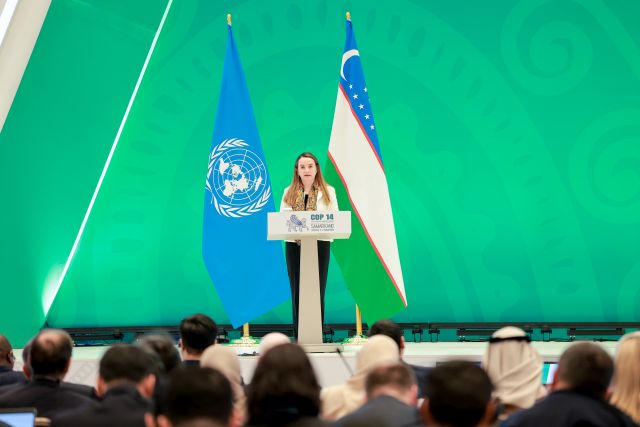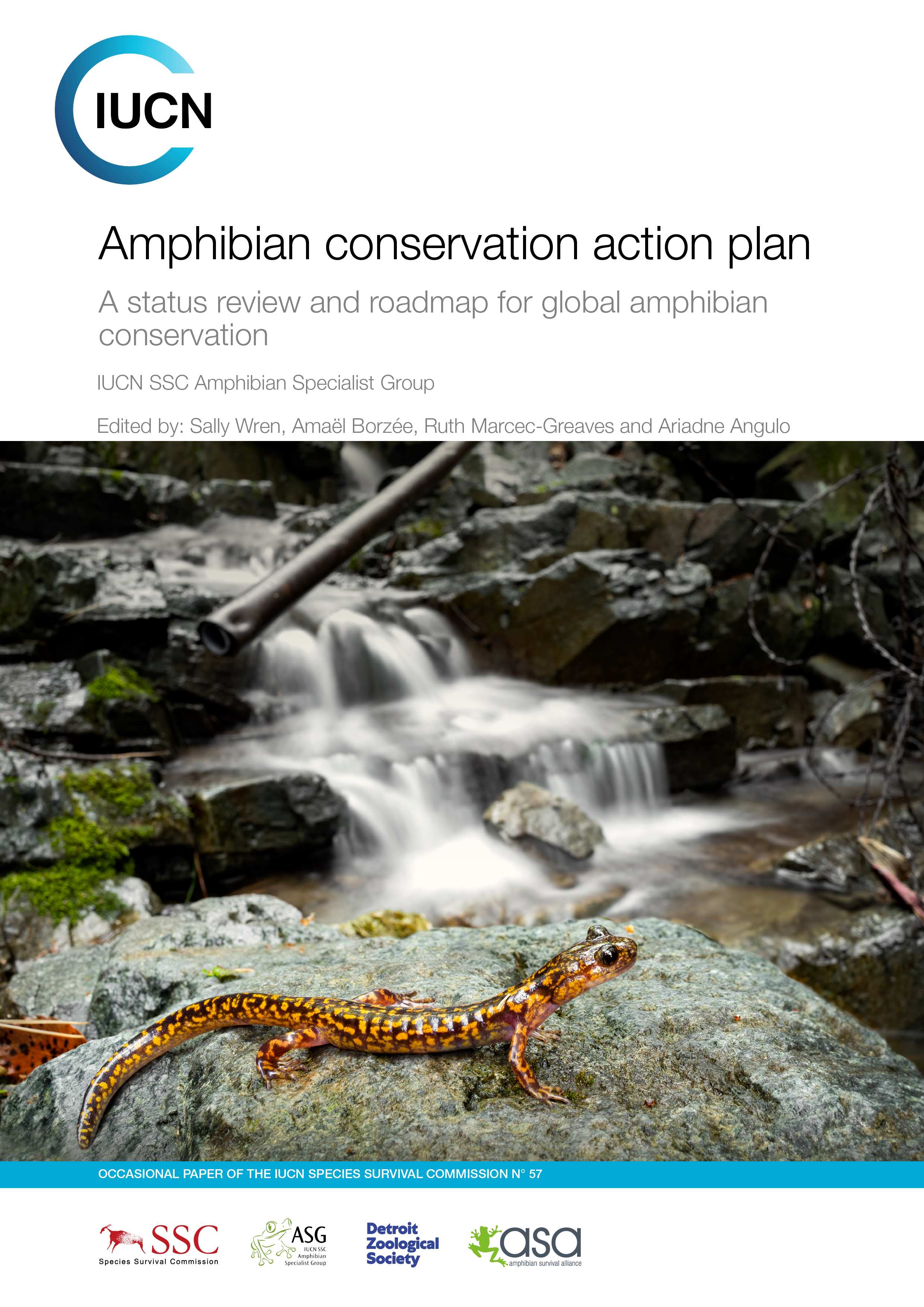CMS COP14: IUCN welcomes the Samarkand Strategic Plan for Migratory Species
IUCN commends governments at the 14th meeting of the Conference of the Parties of the UN Convention on Migratory Species (CMS COP14) for having reached transformative decisions, including the adoption of the Samarkand Strategic Plan for Migratory Species 2024-2032, along with resolutions and decisions concerning deep-seabed mineral exploitation activities and their impact on migratory species. IUCN also celebrates the acknowledgment of the vital role played by Indigenous peoples and local communities in the conservation of migratory species, underscoring inclusive conservation efforts and practices.
CMS COP14 was held from 12 to 17 February in Samarkand, Uzbekistan. This was the first biodiversity-related global meeting to be hosted in Central Asia, home to a rich array of migratory species, including the saiga antelope, the snow leopard, and the steppe eagle, to name a few. IUCN congratulates the Government of Uzbekistan for its exemplary stewardship in convening CMS COP14, with Aziz Abdukhakimov, Minister of Ecology, Environmental Protection and Climate Change of Uzbekistan, leading the proceedings with commendable dedication.
“As a membership Union, IUCN believes in the power of partnerships, and in the power of collaborative, innovative solutions that transcend national boundaries. It is only through our collective efforts that we can truly make a difference for migratory species, the ecosystems they inhabit, and by extension, our own well-being,” said Dr Grethel Aguilar, IUCN Director General.
 Dr Grethel Aguilar, IUCN Director General, addressing the plenary at the CMS COP14 opening ceremony
Photo: Ministry of Ecology, Environmental Protection and Climate Change of Uzbekistan
Dr Grethel Aguilar, IUCN Director General, addressing the plenary at the CMS COP14 opening ceremony
Photo: Ministry of Ecology, Environmental Protection and Climate Change of Uzbekistan
Drawing on its extensive experience and expertise, anchored in the IUCN Species Survival Commission (SSC), the Union remains committed to supporting CMS Parties by providing technical advice on species conservation status and conducting scientific evaluations of proposed amendments to CMS appendices. As a trusted partner in global conservation, IUCN looks forward to continued collaboration with stakeholders to advance the protection of migratory species and their habitats.
“Once again, I have been deeply impressed by the dedication, knowledge, and passion of members of the IUCN Species Survival Commission (SSC),” says Dr Jon Paul Rodríguez, Chair of the IUCN Species Survival Commission. “Their enthusiasm and professionalism were evident as they offered invaluable technical advice and scientific evaluations to the Parties, guiding our discussions and shaping the decisions ultimately adopted as resolutions in Samarkand. These resolutions will guide the actions under the CMS across the globe.”
 IUCN delegation at the CMS COP14 opening ceremony
Photo: Ministry of Ecology, Environmental Protection and Climate Change of Uzbekistan
IUCN delegation at the CMS COP14 opening ceremony
Photo: Ministry of Ecology, Environmental Protection and Climate Change of Uzbekistan
With over 15 side events, IUCN contributed to the overarching discussions, facilitating the exchange of knowledge, tools, and best practices related to the conservation of migratory species. Notably, one of these side events marked the launch of IUCN's One Health nature conservation project in Central Asia, aimed at enhancing landscape resilience to mitigate zoonotic outbreaks. A significant milestone was achieved as CMS and IUCN signed a Memorandum of Understanding, reinforcing their commitment to supporting the priorities of the joint CITES-CMS African Carnivores Initiative (ACI). Furthermore, an announcement was made at CMS COP14 regarding the First World Species Congress, scheduled to be held online on 15 May 2024 and hosted by Reverse the Red.
After the conference in Samarkand, the CMS COP Presidency stays with the Government of Uzbekistan for the next three years. In his closing words, Aziz Abdukhakimov, COP President and the Minister of Ecology, Environmental Protection, and Climate Change of Uzbekistan reaffirmed his country's dedication to cross-border collaboration for the protection of migratory species, particularly in the Central Asian region.
Highlights from the CMS COP14
- The first-ever State of the World’s Migratory Species report revealed a decline in populations for many migratory species, and indicated the risk of global extinction was increasing;
- The launch of the new Global Partnership on Ecological Connectivity (GPEC), which aims to ensure ecological connectivity is maintained, enhanced, and restored in critical areas for migratory species, supported by the IUCN World Commission on Protected Areas Connectivity Conservation Group (CCSG) and the Center for Large Landscape Conservation (CCSG), amongst others;
- An agreement on a Central Asian Flyway spanning 30 Range States for migratory birds, alongside the establishment of a coordinating unit in India with financial support from the Indian Government;
- The adoption of an action plan for severely threatened populations of great bustards in Asia;
- The inscription of two cat species, the Eurasian lynx (including its Critically Endangered subspecies, the Balkan lynx), and the Pallas’s cat or manul, on the list of species protected under the CMS. Notably, this marks the first instance of CMS action for a terrestrial species in Europe;
- The agreement to launch a joint CMS CITES Jaguar Initiative, and to develop a comprehensive programme of work encompassing all aspects of jaguar conservation;
- Adoption of a resolution urging Parties to refrain from engaging in or supporting deep-seabed mining until sufficient scientific information ensures no harmful effects on migratory species, their prey, and ecosystems;
- Strengthened mandate on addressing bycatch and aquatic wild meat, particularly concerning small cetaceans, sharks, marine turtles, and seabirds; and
- Introduction of three new action plans for aquatic species: the Atlantic humpback dolphin, the hawksbill turtle, and the angelshark.



